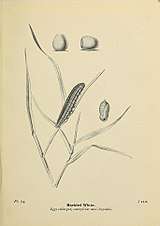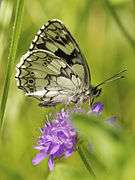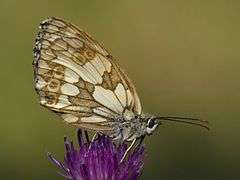Melanargia galathea
Melanargia galathea, the marbled white, is a butterfly in the family Nymphalidae.[1]
| Marbled white | |
|---|---|
_male.jpg) | |
| Male, upperside Whitecross Green Wood, Oxfordshire, England | |
_female.jpg) | |
| male, upperside | |
| Scientific classification | |
| Kingdom: | |
| Phylum: | |
| Class: | |
| Order: | |
| Family: | |
| Genus: | |
| Species: | M. galathea |
| Binomial name | |
| Melanargia galathea | |
The marbled white was called "Our Half-mourner" by James Petiver (1717), "The Marmoris" by Benjamin Wilkes and "The Marmoress" by Moses Harris. Despite its common name and appearance, this butterfly is one of the "browns", of the subfamily Satyrinae.
Subspecies
Subspecies include:[2]
- Melanargia galathea galathea Europe, southern Urals
- Melanargia galathea donsa Fruhstorfer, 1916 Caucasus
- Melanargia galathea lucasi (Rambur, 1858) North Africa
- Melanargia galathea satnia Fruhstorfer, 1917 (= njurdzhan Sheljuzhko) Caucasus Major and Minor
- Melanargia galathea tenebrosa Fruhstorfer, 1917
Distribution
This species can be found across most of Europe, southern Russia, Asia Minor and Iran. There is an isolated population in Japan. It is not found in Ireland, North Britain, Scandinavia (except Denmark) and Portugal or Spain. The late twentieth century saw an expansion of its range in the UK.[3][4][2]
Habitat
It is found in forest clearings and edges, meadows and steppe where it occurs up to 1,500-1,700 m above sea level.[4] They are a common sight in unimproved grasslands across southern Britain, particularly on the South Downs, but also extending slightly further north to places such as the Dunstable Downs.
Description

Melanargia galathea has a wingspan of 46–56 millimetres (1.8–2.2 in).[5] In these medium-sized butterflies the upper side of the wings is decorated with white and gray-black or dark brown markings, but it is always gray-black or dark brown checkered in the basal and distal areas. The underside is similar to the upper side but the drawings is light gray or light brown. On the underside of the hindwings is present a row of gray eye spots. The males and the females are quite similar, except that some females may have a yellowish nuance on the underside of the wings. Seitz - M. galathea. In the otherwise black cell of both wing an oval white spot which is not divided bya transverse bar. On the hindwing above the ocelli are quite invisible or shine through very faintly from the underside.[6]
This species is rather similar to the Iberian marbled white (Melanargia lachesis) that replaces M. galathea in Spain and southern France.
The caterpillars are about 28 millimeters long. They are green or yellow with some lighter and darker narrow longitudinal lines. The head is always light brown.
Life cycle
Like other members of its subfamily, the larvae feed on various grasses. These include Phleum (P. pratense), Poa (P. annua, P. trivalis), Festuca rubra, Bromus erectus, Dactylis, Brachypodium pinnatum, Agrostis capillaris, Elytrigia, Holcus, Dactylis, Triticum and Agropyron species .[2]
Eggs are laid on the wing, or from brief perches on grass stems, and are just sprinkled among the grass stems. Upon hatching, the larvae immediately enter hibernation and only feed the following spring when the fresh growth occurs. They are a lime-green colour, with a dark green line running down the middle of their back. Pupation takes place at ground level in a loose cocoon. Adults can be found from early June to early September.[4] On a good site, in warm, sunny weather, thousands can be seen gently fluttering amongst the grass heads.
Gallery
- Melanargia galathea
- Mating
 Male, ventral side
Male, ventral side Female, ventral view
Female, ventral view
References
| Wikispecies has information related to Melanargia galathea |
| Wikimedia Commons has media related to Melanargia galathea. |
- Catalogue of life
- "Melanargia Meigen, 1828" at Markku Savela's Lepidoptera and Some Other Life Forms
- Fauna europaea
- Satyrinae of the Western Palearctic - Melanargia galathea
- "European Butterfly Guide". Archived from the original on 2009-05-15. Retrieved 2017-08-07.
- Seitz. A. in Seitz, A. ed. Band 1: Abt. 1, Die Großschmetterlinge des palaearktischen Faunengebietes, Die palaearktischen Tagfalter, 1909, 379 Seiten, mit 89 kolorierten Tafeln (3470 Figuren)

External links
- Lepiforum
- Paolo Mazzei, Daniel Morel, Raniero Panfili Moths and Butterflies of Europe and North Africa
- Kimmo Silvonen Larvae of North-European Lepidoptera